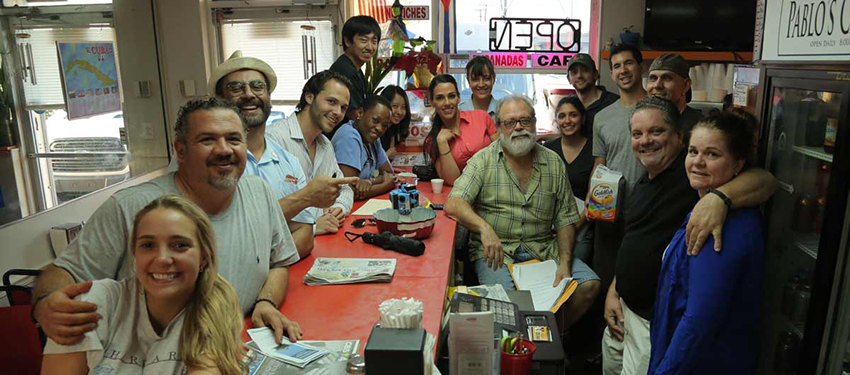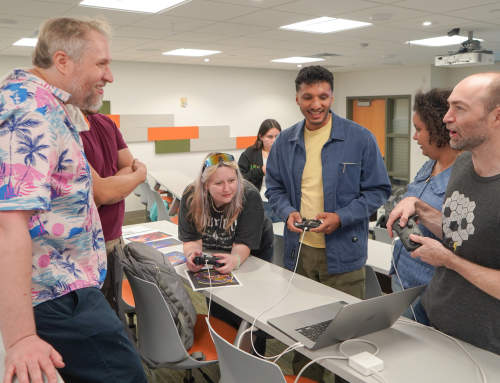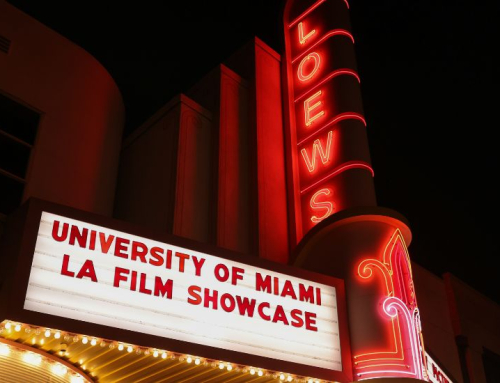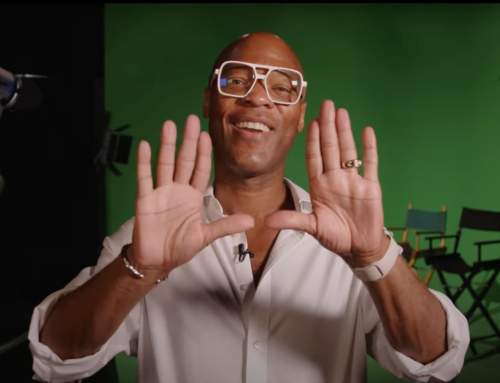In a strip mall on Eighth Street in Miami’s Little Havana neighborhood, there’s a typical Cuban coffee shop named Pablo’s Cafecito. The only way to get a seat at the counter is to put on your Oculus.
Pablo’s Cafecito is the setting for Calle Ocho, the University of Miami School of Communication’s first venture into 360 degree filming. Previous films using virtual reality (VR) technology have taken viewers to the tops of mountains or on bike rides through the country. Calle Ocho is the first student-produced narrative 360 degree film, telling the story of what happens when the regulars in a Cuban coffee shop win the lottery.
Professor Kim Grinfeder saw the potential in tying VR technology with motion pictures, and shared his idea of making a narrative film with Ed Talavera, professor and chair of the Department of Cinema and Interactive Media.
“People are using the Oculus to film crazy things. Basically things like jumping off cliffs, going underwater, jumping with a parachute, and things like that. But there was no story, no narrative. I showed it to Ed and told him we need to do a story. Let’s do a movie,” recalled Grinfeder.
Talavera was receptive, but didn’t know how to use the technology to produce a narrative film. Neither did Grinfeder. The two of them began researching, but they soon realized there wasn’t much information out there. Filming in VR is a new arena and, with few resources available, a lot of the learning would have to take place through trial and error.
Talavera tapped MFA student Zulena Segarra Berrios to direct the film. She was already working on developing a TV sitcom pilot with Professor Rafael Lima’s script, Calle Ocho, and Lima and Berrios both agreed the setting and characters would be a perfect fit for this technology.
“Since a sitcom is so much like theater and theater happens in one static location, and all the characters revolve around that location, it worked happily,” says Lima.
Filming a narrative in 360 degrees created many challenges for the director and screenwriter. Calle Ocho was completed through the use of six GoPros on a rig designed for VR filming. Each GoPro films one area of the scene, then the six areas are “stitched” into one film creating a virtual reality for the viewer.
Part of the art of film is the control given to the filmmaker to decide what the viewer sees. With 360 degree filming, the viewer chooses what to focus on, a concept similar to theater.
“Now the viewer is the director in the sense that instead of me telling you what to look at, the viewer decides. If I said a woman’s hand picks up that cup, you may not want to look at that. It’s the viewer that now directs their eye inside the film. That’s a completely different change from what it used to be which is the writer writes it, the director shoots it, and you are handed the view rather than you choosing it,” says Lima.
The platform also presented production challenges, and Berrios quickly learned the normal protocol on a film set would not work.
“Usually the crew works hard, hard, hard, hard. They’re on set all the time until the cast comes in and the crew kinda stays there. They know exactly what’s going on. Then we cut, and the actors go back into their dressing room, and the crew changes the setup. For Calle Ocho, we had to have our crew there very early and they had to hide a light here, hide a microphone here, hide this there, so that it didn’t show up on camera. And then they had to leave the set and not come back until we yelled cut,” says Zulena.
Calle Ocho was a learning experience, and everyone involved left the project with more ideas for filming in 360 degrees. Lima envisions “using this technology to shoot five or six different endings to a film” where the viewer’s choices determines the ending.
“Imagine if you go through a room you get shot, you go through another room, you get the girl, you go through a third door you get shot, but you get the girl,” says Lima.
Next semester, Talavera and Grinfeder are co-teaching a class on 360 VR filming, positing students to be creative. Grinfeder is teaching the technical side and Talavera the filmmaking and production side. The concept for the class is to have motion pictures’ students develop innovative uses for virtual reality in film while having interactive media students researching how to make the ideas possible.
“I think if anyone is going to figure this stuff out it’s going to be students. They don’t have those walls built around them that this can be done or this can’t be done. As a student everything is possible,” says Grinfeder.
The school has a new virtual reality lab for projects, including three computers that have been equipped with editing software to stitch the videos produced by the GoPros into a seamless film.
Grinfeder hopes to one day have a virtual reality pit in the School of Communication to create virtual worlds that can be used to create new immersive environments for training and to research new therapies. For example, USC is using VR to treat PTSD and Duke is using the technology to treat phobias.
“What the school really needs is a virtual reality pit. Right now the problem with VR is that you are tethered, but there are kits that you can put the VR on and have it go wireless and you can walk around the space and experience it. That’s the future. Untethered and you have to be able to walk around,” says Grinfeder.
To view the film, visit http://calle8movie.com/.







